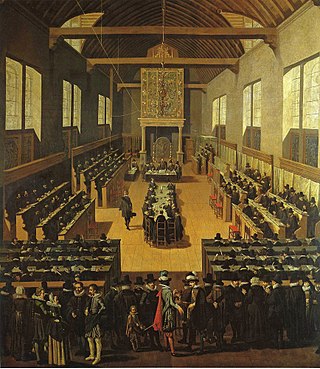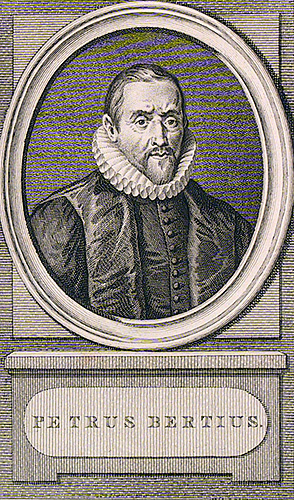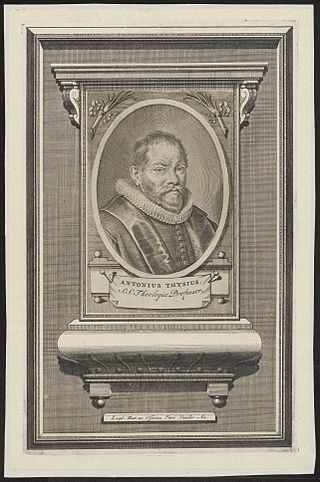Related Research Articles

Arminianism is a movement of Protestantism initiated in the early 17th century, based on the theological ideas of the Dutch Reformed theologian Jacobus Arminius and his historic supporters known as Remonstrants. Dutch Arminianism was originally articulated in the Remonstrance (1610), a theological statement submitted to the States General of the Netherlands. This expressed an attempt to moderate the doctrines of Calvinism related to its interpretation of predestination.

Hugo Grotius, also known as Huig de Groot and Hugo de Groot, was a Dutch humanist, diplomat, lawyer, theologian, jurist, statesman, poet and playwright. A teenage prodigy, he was born in Delft and studied at Leiden University. He was imprisoned in Loevestein Castle for his involvement in the controversies over religious policy of the Dutch Republic, but escaped hidden in a chest of books that was transported to Gorinchem. Grotius wrote most of his major works in exile in France.

The Synod of Dort was an international Synod held in Dordrecht in 1618–1619, by the Dutch Reformed Church, to settle a divisive controversy caused by the rise of Arminianism. The first meeting was on 13 November 1618 and the final meeting, the 180th, was on 29 May 1619. Voting representatives from eight foreign Reformed churches were also invited. Dort was a contemporary Dutch term for the town of Dordrecht.

Jacobus Arminius, the Latinized name of Jakob Hermanszoon, was a Dutch Reformed minister and theologian during the Protestant Reformation period whose views became the basis of Arminianism and the Dutch Remonstrant movement. He served from 1603 as professor in theology at the University of Leiden and wrote many books and treatises on theology.

Franciscus Gomarus was a Dutch theologian, a strict Calvinist and an opponent of the teaching of Jacobus Arminius, whose theological disputes were addressed at the Synod of Dort (1618–19).

Simon Episcopius was a Dutch theologian and Remonstrant who played a significant role at the Synod of Dort in 1618. His name is the Latinized form of his Dutch name Simon Bisschop.

The history of the Calvinist–Arminian debate begins in early 17th century in the Netherlands with a Christian theological dispute between the followers of John Calvin and Jacobus Arminius, and continues today among some Protestants, particularly evangelicals. The debate centers around soteriology, or the study of salvation, and includes disputes about total depravity, predestination, and atonement. While the debate was given its Calvinist–Arminian form in the 17th century, issues central to the debate have been discussed in Christianity in some form since Augustine of Hippo's disputes with the Pelagians in the 5th century.

Conrad Vorstius was a German-Dutch heterodox Remonstrant theologian, and successor to Jacobus Arminius in the theology chair at Leiden University. His appointment, and the controversy surrounding it, became an international matter in the political and religious affairs of the United Provinces during the Twelve Years' Truce, supplying a pretext for the irregular intervention of King James I of England in those affairs. Vorstius published theological views which were taken to show sympathy with the Socinians, and was declared a heretic at the Synod of Dort in 1619.

Johannes Wtenbogaert was a Dutch Protestant minister, a leader of the Remonstrants.

Nicolaas Grevinckhoven was a Dutch Protestant minister, a combative proponent of the Remonstrant party.

Arminianism was a controversial theological position within the Church of England particularly evident in the second quarter of the 17th century. A key element was the rejection of predestination. The Puritans fought against Arminianism, and King James I of England opposed it before, during, and after the Synod of Dort, 1618–1619, where the English delegates participated in formulating the Calvinist Canons of Dort, but his son Charles I, favored it, leading to deep political battles. The Methodists, who espoused a variant of the school of thought called Wesleyan–Arminian theology, branched off the Church of England in the 18th century.

Sibrandus Lubbertus (c.1555–1625) was a Dutch Calvinist theologian and was a professor of theology at the University of Franeker for forty years from the institute's foundation in 1585. He was a prominent participant in the Synod of Dort (1618–1619). His primary works were to counter Roman Catholic doctrine and to oppose Socinianism and Arminianism.

Petrus Bertius was a Flemish philosopher, theologian, historian, geographer and cartographer. Bertius published much in mathematics, and historical and theological works, but he is now best known as cartographer with his edition of the Geographia of Ptolemy, and for its atlas.

Antonius Thysius was a Dutch Reformed theologian, professor at the University of Harderwijk and University of Leiden.

Antonius Walaeus was a Dutch Calvinist minister, theologian, and academic.
Samuel Naeranus (1582–1641) was a Dutch Remonstrant minister and Neo-Latin poet, exiled in 1619 after the Synod of Dort.
Johannes Arnoldi Corvinus born Joannes Arnoldsz Ravens was a Dutch Remonstrant minister and jurist.
Matthew Slade (1569–1628) was an English nonconformist minister and royal agent, in the Netherlands by 1600 and active there in the Contra-Remonstrant cause.
Johannes Narssius was a Dutch physician and Neo-Latin poet, initially a Remonstrant minister.

Alma Academia Leidensis refers to an illustrated book about the professors of the University of Leiden, the Netherlands.
References
- Hugo Grotius (2001), De imperio summarum potestatum circa sacra; Google Books.
- Edwin Rabbie (1995), Ordinum Hollandiae ac Westfrisiae Pietas (1613); Google Books.